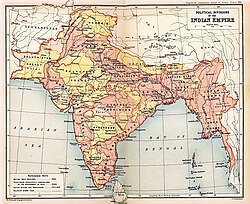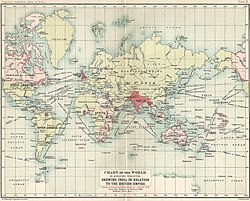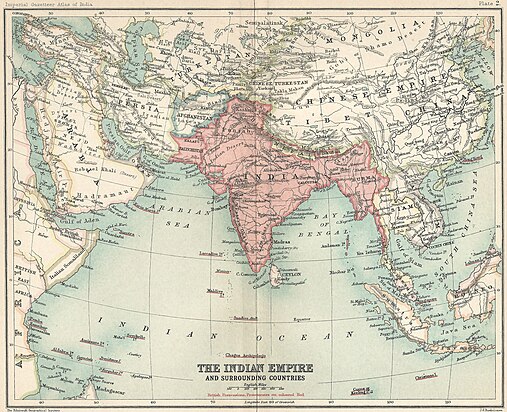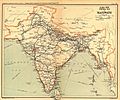A | B | C | D | E | F | G | H | CH | I | J | K | L | M | N | O | P | Q | R | S | T | U | V | W | X | Y | Z | 0 | 1 | 2 | 3 | 4 | 5 | 6 | 7 | 8 | 9
The British Raj (/rɑːdʒ/ RAHJ; from Hindi rāj, 'kingdom', 'realm', 'state', or 'empire')[11][h] was the rule of the British Crown on the Indian subcontinent,[13] lasting from 1858 to 1947.[14] It is also called Crown rule in India,[15] or Direct rule in India.[16] The region under British control was commonly called India in contemporaneous usage and included areas directly administered by the United Kingdom, which were collectively called British India, and areas ruled by indigenous rulers, but under British paramountcy, called the princely states. The region was sometimes called the Indian Empire, though not officially.[17]
As India, it was a founding member of the League of Nations, a participating state in the Summer Olympics in 1900, 1920, 1928, 1932, and 1936, and a founding member of the United Nations in San Francisco in 1945.[18]
This system of governance was instituted on 28 June 1858, when, after the Indian Rebellion of 1857, the rule of the East India Company was transferred to the Crown in the person of Queen Victoria[19] (who, in 1876, was proclaimed Empress of India). It lasted until 1947, when the British Raj was partitioned into two sovereign dominion states: the Union of India (later the Republic of India) and Pakistan (later the Islamic Republic of Pakistan). Later, the People's Republic of Bangladesh gained independence from Pakistan. At the inception of the Raj in 1858, Lower Burma was already a part of British India; Upper Burma was added in 1886, and the resulting union, Burma, was administered as an autonomous province until 1937, when it became a separate British colony, gaining its own independence in 1948. It was renamed Myanmar in 1989. The Chief Commissioner's Province of Aden was also part of British India at the inception of the British Raj, and became a separate colony known as Aden Colony in 1937 as well.
Geographical extent
The British Raj extended over almost all present-day India, Pakistan, and Bangladesh, except for small holdings by other European nations such as Goa and Pondicherry.[20] This area is very diverse, containing the Himalayan mountains, fertile floodplains, the Indo-Gangetic Plain, a long coastline, tropical dry forests, arid uplands, and the Thar Desert.[21] In addition, at various times, it included Aden (from 1858 to 1937),[22] Lower Burma (from 1858 to 1937), Upper Burma (from 1886 to 1937), British Somaliland (briefly from 1884 to 1898), and the Straits Settlements (briefly from 1858 to 1867). Burma was separated from India and directly administered by the British Crown from 1937 until its independence in 1948. The Trucial States of the Persian Gulf and the other states under the Persian Gulf Residency were theoretically princely states as well as presidencies and provinces of British India until 1947 and used the rupee as their unit of currency.[23]
Among other countries in the region, Ceylon, which was referred to coastal regions and northern part of the island at that time (now Sri Lanka) was ceded to Britain in 1802 under the Treaty of Amiens. These coastal regions were temporarily administered under Madras Presidency between 1793 and 1798,[24] but for later periods the British governors reported to London, and it was not part of the Raj. The kingdoms of Nepal and Bhutan, having fought wars with the British, subsequently signed treaties with them and were recognised by the British as independent states.[25][26] The Kingdom of Sikkim was established as a princely state after the Anglo-Sikkimese Treaty of 1861; however, the issue of sovereignty was left undefined.[27] The Maldive Islands were a British protectorate from 1887 to 1965, but not part of British India.[28]
-
The British Raj and surrounding countries are shown in 1909.
History
1858–1868: rebellion aftermath, critiques, and responses
-
Lakshmibai, Rani of Jhansi, one of the principal leaders of the Great Uprising of 1857, who had lost her kingdom by the Doctrine of lapse
-
The proclamation to the "Princes, Chiefs, and People of India", issued by Queen Victoria on 1 November 1858
-
Sir Syed Ahmed Khan founder of the Muhammadan Anglo-Oriental College, wrote one of the early critiques, The Causes of the Indian Mutiny.
-
An 1887 souvenir portrait of Queen Victoria as Empress of India, 30 years after the Great Uprising
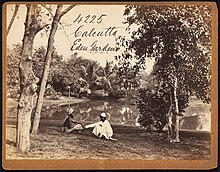


Although the Indian Rebellion of 1857 had shaken the British enterprise in India, it had not derailed it. Until 1857, the British, especially under Lord Dalhousie, had been hurriedly building an India which they envisaged to be on par with Britain itself in the quality and strength of its economic and social institutions. After the rebellion, they became more circumspect. Much thought was devoted to the causes of the rebellion and three main lessons were drawn. First, at a practical level, it was felt that there needed to be more communication and camaraderie between the British and Indians—not just between British army officers and their Indian staff but in civilian life as well.[29] The Indian army was completely reorganised: units composed of the Muslims and Brahmins of the United Provinces of Agra and Oudh, who had formed the core of the rebellion, were disbanded. New regiments, like the Sikhs and Baluchis, composed of Indians who, in British estimation, had demonstrated steadfastness, were formed. From then on, the Indian army was to remain unchanged in its organisation until 1947.[30] The 1861 Census had revealed that the English population in India was 125,945. Of these only about 41,862 were civilians as compared with about 84,083 European officers and men of the Army.[31] In 1880, the standing Indian Army consisted of 66,000 British soldiers, 130,000 Natives, and 350,000 soldiers in the princely armies.[32]
Second, it was also felt that both the princes and the large land-holders, by not joining the rebellion, had proved to be, in Lord Canning's words, "breakwaters in a storm".[29] They too were rewarded in the new British Raj by being integrated into the British-Indian political system and having their territories guaranteed.[33] At the same time, it was felt that the peasants, for whose benefit the large land reforms of the United Provinces had been undertaken, had shown disloyalty, by, in many cases, fighting for their former landlords against the British. Consequently, no more land reforms were implemented for the next 90 years: Bengal and Bihar were to remain the realms of large land holdings (unlike the Punjab and Uttar Pradesh).[34]
Third, the British felt disenchanted with Indian reaction to social change. Until the rebellion, they had enthusiastically pushed through social reform, like the ban on sati by Lord William Bentinck.[35] It was now felt that traditions and customs in India were too strong and too rigid to be changed easily; consequently, no more British social interventions were made, especially in matters dealing with religion,[36] even when the British felt very strongly about the issue (as in the instance of the remarriage of Hindu child widows).[37] This was exemplified further in Queen Victoria's Proclamation released immediately after the rebellion. The proclamation stated that 'We disclaim alike our Right and Desire to impose Our Convictions on any of Our Subjects';[38] demonstrating official British commitment to abstaining from social intervention in India.
1858–1880: railways, canals, Famine Code
-
The 1909 map of Indian Railways, the fourth largest in the world. Railway construction began in 1853.
-
Stereographic image of Victoria Terminus, Bombay, completed in 1888
-
The Agra canal (c. 1873), a year from completion, was closed to navigation in 1904 to increase irrigation during a famine.
-
Lord Ripon, the Liberal Viceroy of India, who instituted the Famine Code. 1880.
In the second half of the 19th century, both the direct administration of India by the British crown and the technological change ushered in by the industrial revolution, had the effect of closely intertwining the economies of India and Great Britain.[39] In fact many of the major changes in transport and communications (that are typically associated with Crown Rule of India) had already begun before the Mutiny. Since Dalhousie had embraced the technological change then rampant in Great Britain, India too saw the rapid development of all those technologies. Railways, roads, canals, and bridges were rapidly built in India, and telegraph links were equally rapidly established so that raw materials, such as cotton, from India's hinterland, could be transported more efficiently to ports, such as Bombay, for subsequent export to England.[40] Likewise, finished goods from England, were transported back for sale in the burgeoning Indian markets.[41] Unlike Britain, where the market risks for the infrastructure development were borne by private investors, in India, it was the taxpayers—primarily farmers and farm-labourers—who endured the risks, which, in the end, amounted to £50 million.[42] Despite these costs, very little skilled employment was created for Indians. By 1920, with the fourth largest railway network in the world and a history of 60 years of its construction, only ten per cent of the "superior posts" in the Indian Railways were held by Indians.[43]
The rush of technology was also changing the agricultural economy in India: by the last decade of the 19th century, a large fraction of some raw materials—not only cotton, but also some food-grains—were being exported to faraway markets.[44] Many small farmers, dependent on the whims of those markets, lost land, animals, and equipment to money-lenders.[44] The latter half of the 19th century also saw an increase in the number of large-scale famines in India. Although famines were not new to the subcontinent, these were particularly severe, with tens of millions dying,[citation needed] and with many critics, both British and Indian, laying the blame at the doorsteps of the lumbering colonial administrations.[44] There were also salutary effects: commercial cropping, especially in the newly canalled Punjab, led to increased food production for internal consumption.[45] The railway network provided critical famine relief,[46] notably reduced the cost of moving goods,[46] and helped nascent Indian-owned industry.[45] After, the Great Famine of 1876–1878, The Indian Famine Commission report was issued in 1880, and the Indian Famine Codes, the earliest famine scales and programmes for famine prevention, were instituted.[47] In one form or other, they would be implemented worldwide by the United Nations and the Food and Agricultural Organisation well into the 1970s.[citation needed]
1880s–1890s: middle class, Indian National Congress
-
Allan Octavian Hume (1829–1912), who proposed the idea of the Indian National Congress in a letter to graduates of Calcutta University
-
Congress, Bombay, December 28, 1885. Third row (middle) (l. to r.) Dadabhai Naoroji, Hume, W. C. Bonerjee, and Pherozeshah Mehta.
-
Poverty and the Un-British Rule in India, 1901, by Naoroji, Member, British Parliament (1892–1895), and Congress president (1886, 1893, 1906)
-
Mehta, lawyer, businessman, and president of the sixth session of the Indian National Congress in 1890
By 1880, a new middle class had arisen in India and spread thinly across the country. Moreover, there was a growing solidarity among its members, created by the "joint stimuli of encouragement and irritation".[48] The encouragement felt by this class came from its success in education and its ability to avail itself of the benefits of that education such as employment in the Indian Civil Service. It came too from Queen Victoria's proclamation of 1858 in which she had declared, "We hold ourselves bound to the natives of our Indian territories by the same obligation of duty which bind us to all our other subjects."[49] Indians were especially encouraged when Canada was granted dominion status in 1867 and established an autonomous democratic constitution.[49] Lastly, the encouragement came from the work of contemporaneous Oriental scholars like Monier Monier-Williams and Max Müller, who in their works had been presenting ancient India as a great civilisation. Irritation, on the other hand, came not just from incidents of racial discrimination at the hands of the British in India, but also from governmental actions like the use of Indian troops in imperial campaigns (e.g. in the Second Anglo-Afghan War) and the attempts to control the vernacular press (e.g. in the Vernacular Press Act of 1878).[50]
It was, however, Viceroy Lord Ripon's partial reversal of the Ilbert Bill (1883), a legislative measure that had proposed putting Indian judges in the Bengal Presidency on equal footing with British ones, that transformed the discontent into political action.[51] On 28 December 1885, professionals and intellectuals from this middle-class — many educated at the new British-founded universities in Bombay, Calcutta, and Madras, and familiar with the ideas of British political philosophers, especially the utilitarians assembled in Bombay — founded the Indian National Congress. The 70 men elected Womesh Chunder Bonerjee as the first president. The membership comprised a westernised elite, and no effort was made at this time to broaden the base.[citation needed]
During its first 20 years, the Congress primarily debated British policy toward India. Its debates created a new Indian outlook that held Great Britain responsible for draining India of its wealth. Britain did this, the nationalists claimed, by unfair trade, by the restraint on indigenous Indian industry, and by the use of Indian taxes to pay the high salaries of the British civil servants in India.[52]
Thomas Baring served as Viceroy of India 1872–1876. Baring's major accomplishments came as an energetic reformer who was dedicated to upgrading the quality of government in the British Raj. He began large scale famine relief, reduced taxes, and overcame bureaucratic obstacles in an effort to reduce both starvation and widespread social unrest. Although appointed by a Liberal government, his policies were much the same as viceroys appointed by Conservative governments.[53]
Social reform was in the air by the 1880s. For example, Pandita Ramabai, poet, Sanskrit scholar, and a champion of the emancipation of Indian women, took up the cause of widow remarriage, especially of Brahmin widows, later converted to Christianity.[54] By 1900 reform movements had taken root within the Indian National Congress. Congress member Gopal Krishna Gokhale founded the Servants of India Society, which lobbied for legislative reform (for example, for a law to permit the remarriage of Hindu child widows), and whose members took vows of poverty, and worked among the untouchable community.[55]
By 1905, a deep gulf opened between the moderates, led by Gokhale, who downplayed public agitation, and the new "extremists" who not only advocated agitation, but also regarded the pursuit of social reform as a distraction from nationalism. Prominent among the extremists was Bal Gangadhar Tilak, who attempted to mobilise Indians by appealing to an explicitly Hindu political identity, displayed, for example, in the annual public Ganapati festivals that he inaugurated in western India.[56]
1905–1911: Partition of Bengal, Swadeshi, violence
>Text je dostupný pod licencí Creative Commons Uveďte autora – Zachovejte licenci, případně za dalších podmínek. Podrobnosti naleznete na stránce Podmínky užití.
Presidencies and provinces of British India
God Save the King
File:British Indian Empire 1909 Imperial Gazetteer of India.jpg
British India
Kingdom of Sikkim
Kingdom of Nepal
Bhutan
Princely states
File:India-or-British-Raj-in-British-Empire-1909.jpg
British Empire
Princely States
Calcutta
New Delhi
English language
Hindustani language
Urdu
Languages of India
Demonym
British Empire
Emperor of India
Queen Victoria
Edward VII
George V
Edward VIII
George VI
Governor-General of India
Charles Canning, 1st Earl Canning
Louis Mountbatten, 1st Earl Mountbatten of Burma
Secretary of State for India
Edward Stanley, 15th Earl of Derby
William Hare, 5th Earl of Listowel
Imperial Legislative Council
Indian Rebellion of 1857
Government of India Act 1858
Indian Independence Act 1947
Partition of India
Indian rupee
Company rule in India
Azad Hind
Dominion of India
Dominion of Pakistan
Persian Gulf Residency
Azad Hind
British rule in Burma
Aden Colony
British Somaliland
Straits Settlements
Help:IPA/English
Help:Pronunciation respelling key
Hindi language
The Crown
Indian subcontinent
United Kingdom of Great Britain and Ireland
Presidencies and provinces of British India
British paramountcy
Princely state
League of Nations
India at the Olympics
India at the 1900 Summer Olympics
India at the 1920 Summer Olympics
India at the 1928 Summer Olympics
India at the 1932 Summer Olympics
India at the 1936 Summer Olympics
Member states of the United Nations
United Nations
United Nations Conference on International Organization
Indian Rebellion of 1857
Company rule in India
East India Company
Queen Victoria
Empress of India
Partition of India
Dominion
Dominion of India
India
Dominion of Pakistan
Pakistan
Bangladesh
Lower Burma
Upper Burma
British rule in Burma
Myanmar
Chief Commissioner's Province of Aden
Colony
Aden Colony
Goa
Pondicherry
Indo-Gangetic Plain
Thar Desert
Aden Province
Lower Burma
Upper Burma
British Somaliland
Straits Settlements
Trucial States
Persian Gulf
Persian Gulf Residency
Presidencies and provinces of British India
Rupee
British Ceylon
Sri Lanka
Treaty of Amiens
Madras Presidency
Kingdom of Nepal
Bhutan
Kingdom of Sikkim
Maldives
Protectorate
File:British Raj and surrounding countries 1909.jpg
History of the British Raj
File:Rani of jhansi.jpg
Rani Lakshmibai
Indian Rebellion of 1857
Doctrine of lapse
File:Image victoria proclamation1858c.JPG
Queen Victoria
File:SAKhan.jpg
Sir Syed Ahmed Khan
Muhammadan Anglo-Oriental College
File:Victoria empress india1.jpg
Empress of India
File:Eden Gardens, Calcutta by Francis Frith (1).jpg
Francis Frith
File:Government House, Calcutta by Francis Frith (1).jpg
Francis Frith
File:Bombay buildings by Francis Frith.jpg
Francis Frith
Indian Rebellion of 1857
James Broun-Ramsay, 1st Marquess of Dalhousie
United Provinces of Agra and Oudh
Uttar Pradesh
Sati (practice)
Lord William Bentinck
File:India railways1909a.jpg
Indian Railways
File:Victoriaterminus1903.JPG
Victoria Terminus
Bombay
File:Agra canal headworks1871a.jpg
Agra canal
File:George Robinson 1st Marquess of Ripon.jpg
George Robinson, 1st Marquess of Ripon
British India
British crown
Bombay
Infrastructure
Famine in India
Wikipedia:Citation needed
Great Famine of 1876–1878
Indian Famine Codes
Famine scale
Wikipedia:Citation needed
Indian National Congress
File:A O Hume.jpg
Allan Octavian Hume
Indian National Congress
Calcutta University
File:1st INC1885.jpg
Bombay
Dadabhai Naoroji
Womesh Chandra Bonerjee
Pherozeshah Mehta
File:Poverty and Un British Rule in India1.jpg
File:Pherozeshah Mehta (portrait).jpg
Pherozeshah Mehta
Indian National Congress
Indian Civil Service
Canadian Confederation
Monier Monier-Williams
Max Müller
Second Anglo-Afghan War
Vernacular Press Act
Lord Ripon
Ilbert Bill
Bengal Presidency
Utilitarianism#Classical utilitarianism
Indian National Congress
Womesh Chunder Bonnerjee
Wikipedia:Citation needed
Thomas Baring, 1st Earl of Northbrook
Pandita Ramabai
Gopal Krishna Gokhale
Servants of India Society
Dalits
Bal Gangadhar Tilak
Ganapati
Partition of Bengal (1905)
Swadeshi movement
British Raj
British Raj
British Raj
Main Page
Wikipedia:Contents
Portal:Current events
Special:Random
Wikipedia:About
Wikipedia:Contact us
Special:FundraiserRedirector?utm source=donate&utm medium=sidebar&utm campaign=C13 en.wikipedia.org&uselang=en
Help:Contents
Help:Introduction
Wikipedia:Community portal
Special:RecentChanges
Wikipedia:File upload wizard
Main Page
Special:Search
Help:Introduction
Special:MyContributions
Special:MyTalk
ब्रिटिश राज
الراج البريطاني
ব্ৰিটিছ ৰাজ
Raj británicu
Müstəmləkə Hindistanı
بریتانیا هیندوستانی
ব্রিটিশ ভারত
Eng-kok léng Ìn-tō͘ Tè-kok
Британия Һиндостаны
Брытанская Індыя
Брытанская Індыя
ब्रिटिश राज
Британска Индия
Raj breizhveuriat
Raj Britànic
Britská Indie
Y Raj Prydeinig
Βρετανικές Ινδίες
India británica
Britainiar Raj
راج بریتانیا
Raj britannique
Réimeas Briotanach
Raj Británico
Yîn-koet liâng Yin-thu Ti-koet
인도 제국
Բրիտանական Հնդկաստան
ब्रिटिश राज
Britanska Indija
Raj Britania Raya
Impero anglo-indiano
הראג' הבריטי
ბრიტანეთის ინდოეთი
بَرطٲنوی ہِند
Uhindi ya Kiingereza
Britu Indija
Britų Indija
ब्रिटिश राज
Британска Индија
ബ്രിട്ടീഷ് രാജ്
ब्रिटिश राज
الراج البريطانى
Raj British
Ĭng-guók liāng Éng-dô Dá̤-guók
ဗြိတိသျှရာဇ
Brits-Indië
ब्रिटिस राज
イギリス領インド帝国
Britisk India
Britisk India
Raj Britanic
Britaniya Hindistoni
ਬਰਤਾਨਵੀ ਰਾਜ
برطانوی راج
برېتانوي هند
Indie Brytyjskie
Índia britânica
India Britanică
Брітаньска Індія
Британская Индия
ᱵᱨᱤᱴᱤᱥ ᱨᱟᱡᱽ
برطانوی ہند
Breetish Raj
British Raj
برطانوي راڄ
Britská India
Britanska Indija
بەریتانی ڕاج
Британска Индија
Britanska Indija
Brittiläinen Intia
Brittiska Indien
Britanikong Raj
பிரித்தானியாவின் இந்தியப் பேரரசு
Британия Һиндстаны
భారతదేశంలో బ్రిటిషు పాలన
บริติชราช
Ҳиндустони Бритониё
Britanya Hindistanı
Британська Індія
برطانوی راج
Inpero anglo-indian
Raj thuộc Anh
英属印度
英屬印度
英属印度
Special:EntityPage/Q129286#sitelinks-wikipedia
British Raj
Talk:British Raj
British Raj
British Raj
Special:WhatLinksHere/British Raj
Special:RecentChangesLinked/British Raj
Wikipedia:File Upload Wizard
Special:SpecialPages
Special:EntityPage/Q129286
Category:British Raj
British Raj
British Raj
Wikipedia:Protection policy#semi
British Raj
British Raj
British Raj
Main Page
Wikipedia:Contents
Portal:Current events
Special:Random
Wikipedia:About
Wikipedia:Contact us
Special:FundraiserRedirector?utm source=donate&utm medium=sidebar&utm campaign=C13 en.wikipedia.org&uselang=en
Updating...x
Text je dostupný za podmienok Creative
Commons Attribution/Share-Alike License 3.0 Unported; prípadne za ďalších
podmienok.
Podrobnejšie informácie nájdete na stránke Podmienky
použitia.
